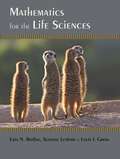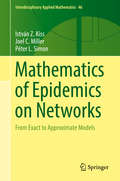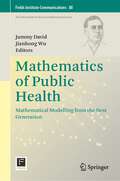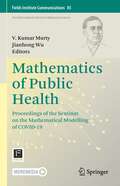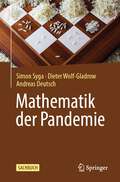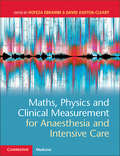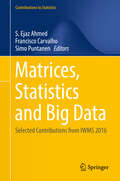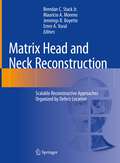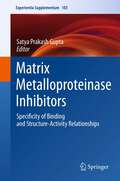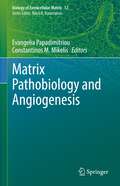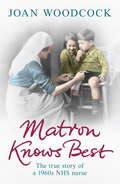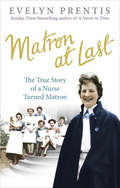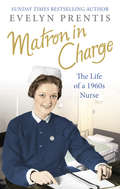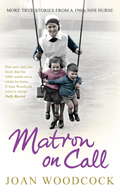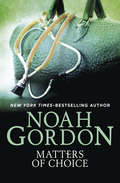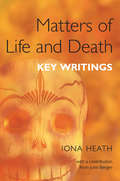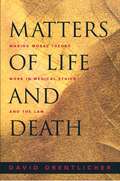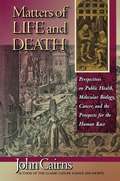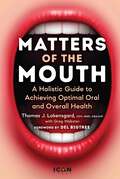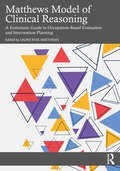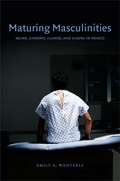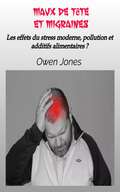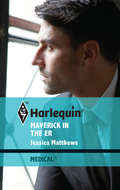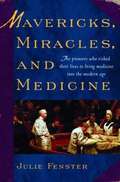- Table View
- List View
Mathematics for the Life Sciences
by Louis J. Gross Suzanne Lenhart Erin N. BodineAn accessible undergraduate textbook on the essential math concepts used in the life sciencesThe life sciences deal with a vast array of problems at different spatial, temporal, and organizational scales. The mathematics necessary to describe, model, and analyze these problems is similarly diverse, incorporating quantitative techniques that are rarely taught in standard undergraduate courses. This textbook provides an accessible introduction to these critical mathematical concepts, linking them to biological observation and theory while also presenting the computational tools needed to address problems not readily investigated using mathematics alone.Proven in the classroom and requiring only a background in high school math, Mathematics for the Life Sciences doesn't just focus on calculus as do most other textbooks on the subject. It covers deterministic methods and those that incorporate uncertainty, problems in discrete and continuous time, probability, graphing and data analysis, matrix modeling, difference equations, differential equations, and much more. The book uses MATLAB throughout, explaining how to use it, write code, and connect models to data in examples chosen from across the life sciences.Provides undergraduate life science students with a succinct overview of major mathematical concepts that are essential for modern biologyCovers all the major quantitative concepts that national reports have identified as the ideal components of an entry-level course for life science studentsProvides good background for the MCAT, which now includes data-based and statistical reasoningExplicitly links data and math modelingIncludes end-of-chapter homework problems, end-of-unit student projects, and select answers to homework problemsUses MATLAB throughout, and MATLAB m-files with an R supplement are available onlinePrepares students to read with comprehension the growing quantitative literature across the life sciencesA solutions manual for professors and an illustration package is available
Mathematics of Epidemics on Networks
by István Z. Kiss Joel C. Miller Péter L. SimonThis textbook provides an exciting new addition to the area of network science featuring a stronger and more methodical link of models to their mathematical origin and explains how these relate to each other with special focus on epidemic spread on networks. The content of the book is at the interface of graph theory, stochastic processes and dynamical systems. The authors set out to make a significant contribution to closing the gap between model development and the supporting mathematics. This is done by: Summarising and presenting the state-of-the-art in modeling epidemics on networks with results and readily usable models signposted throughout the book; Presenting different mathematical approaches to formulate exact and solvable models; Identifying the concrete links between approximate models and their rigorous mathematical representation; Presenting a model hierarchy and clearly highlighting the links between model assumptions and model complexity; Providing a reference source for advanced undergraduate students, as well as doctoral students, postdoctoral researchers and academic experts who are engaged in modeling stochastic processes on networks; Providing software that can solve differential equation models or directly simulate epidemics on networks. Replete with numerous diagrams, examples, instructive exercises, and online access to simulation algorithms and readily usable code, this book will appeal to a wide spectrum of readers from different backgrounds and academic levels. Appropriate for students with or without a strong background in mathematics, this textbook can form the basis of an advanced undergraduate or graduate course in both mathematics and other departments alike.
Mathematics of Public Health: Mathematical Modelling from the Next Generation (Fields Institute Communications #88)
by Jianhong Wu Jummy DavidThis volume addresses SDG 3 from a mathematical standpoint, sharing novel perspectives of existing communicable disease modelling technologies of the next generation and disseminating new developments in modelling methodologies and simulation techniques. These methodologies are important for training and research in communicable diseases and can be applied to other threats to human health. The contributions contained in this collection/book cover a range of modelling techniques that have been and may be used to support decision-making on critical health related issues such as: Resource allocation Impact of climate change on communicable diseases Interaction of human behaviour change, and disease spread Disease outbreak trajectories projection Public health interventions evaluation Preparedness and mitigation of emerging and re-emerging infectious diseases outbreaks Development of vaccines and decisions around vaccine allocation and optimization The diseases and public health issues in this volume include, but are not limited to COVID-19, HIV, Influenza, antimicrobial resistance (AMR), the opioid epidemic, Lyme Disease, Zika, and Malaria. In addition, this volume compares compartmental models, agent-based models, machine learning and network. Readers have an opportunity to learn from the next generation perspective of evolving methodologies and algorithms in modelling infectious diseases, the mathematics behind them, the motivation for them, and some applications to supporting critical decisions on prevention and control of communicable diseases. This volume was compiled from the weekly seminar series organized by the Mathematics for Public Health (MfPH) Next Generation Network. This network brings together the next generation of modellers from across Canada and the world, developing the latest mathematical models, modeling methodologies, and analytical and simulation tools for communicable diseases of global public health concerns. The weekly seminar series provides a unique forum for this network and their invited guest speakers to share their perspectives on the status and future directions of mathematics of public health.
Mathematics of Public Health: Proceedings of the Seminar on the Mathematical Modelling of COVID-19 (Fields Institute Communications #85)
by Jianhong Wu V. Kumar MurtyCurated by the Fields Institute for Research in Mathematical Sciences from their COVID-19 Math Modelling Seminars, this first in a series of volumes on the mathematics of public health allows readers to access the dominant ideas and techniques being used in this area, while indicating problems for further research. This work brings together experts in mathematical modelling from across Canada and the world, presenting the latest modelling methods as they relate to the COVID-19 pandemic. A primary aim of this book is to make the content accessible so that researchers share the core methods that may be applied elsewhere. The mathematical theories and technologies in this book can be used to support decision makers on critical issues such as projecting outbreak trajectories, evaluating public health interventions for infection prevention and control, developing optimal strategies to return to a new normal, and designing vaccine candidates and informing mass immunization program. Topical coverage includes: basic susceptible-exposed-infectious-recovered (SEIR) modelling framework modified and applied to COVID-19 disease transmission dynamics; nearcasting and forecasting for needs of critical medical resources including personal protective equipment (PPE); predicting COVID-19 mortality; evaluating effectiveness of convalescent plasma treatment and the logistic implementation challenges; estimating impact of delays in contact tracing; quantifying heterogeneity in contact mixing and its evaluation with social distancing; modelling point of care diagnostics of COVID-19; and understanding non-reporting and underestimation. Further, readers will have the opportunity to learn about current modelling methodologies and technologies for emerging infectious disease outbreaks, pandemic mitigation rapid response, and the mathematics behind them. The volume will help the general audience and experts to better understand the important role that mathematics has been playing during this on-going crisis in supporting critical decision-making by governments and public health agencies.
Mathematik der Pandemie
by Andreas Deutsch Dieter Wolf-Gladrow Simon SygaDie COVID-19-Pandemie hat weltweit dramatische Folgen. Mathematische Modelle spielen bei ihrer Bewertung eine zentrale Rolle: Sie sollen die Wirkung von Maßnahmen abschätzen, die oft mit Einschränkungen individueller Freiheiten einhergehen. Umso mehr sollte das Wissen um die Mathematik der Pandemie nicht nur Experten überlassen bleiben. Dieses Buch erläutert grundlegende Begriffe und Modelle, und klärt weitverbreitete Missverständnisse auf. Das Buch gibt insbesondere Antwort auf folgende Fragen:Was sagen Kennzahlen wie Inzidenz, Reproduktionszahl, Hospitalisierungsrate oder Impfquote über die Pandemie?Was ist der Unterschied von linearem und exponentiellem Wachstum?Was ist Herdenimmunität? Warum werden sich trotz Herdenimmunität fast alle Ungeimpften anstecken?Was ist der Effekt von Kontaktbeschränkungen und Impfung?Warum sind Vorhersagen in der Pandemie schwierig?
Maths, Physics and Clinical Measurement for Anaesthesia and Intensive Care
by David Hozefa Ebrahim Ashton-ClearyMaths, physics and clinical measurement hold a degree of mystery and trepidation for many working and training in anaesthesia, intensive care and theatre practice. This important new book covers these core topics in a logical and structured format, creating a more enjoyable learning experience that is accessible and easy to digest. Each chapter opens with a set of learning objectives and summary of chapter contents. Following this is a clinical scenario that relates to the themes of the chapter and a number of hypothetical questions relating to the scenario are laid-out. Clinical pearls are presented in boxes for more advanced learning opportunities. Each chapter closes with a set of MCQ or SBA self-test questions to test the readers' knowledge of the chapter. This book covers everything needed for the FFICM and FRCA exams, making it an essential text for exam candidates, tutors, and those working in theatres, anaesthesia and the ICU.
Matrices, Statistics and Big Data: Selected Contributions from IWMS 2016 (Contributions to Statistics)
by S. Ejaz Ahmed Simo Puntanen Francisco CarvalhoThis volume features selected, refereed papers on various aspects of statistics, matrix theory and its applications to statistics, as well as related numerical linear algebra topics and numerical solution methods, which are relevant for problems arising in statistics and in big data. The contributions were originally presented at the 25th International Workshop on Matrices and Statistics (IWMS 2016), held in Funchal (Madeira), Portugal on June 6-9, 2016. The IWMS workshop series brings together statisticians, computer scientists, data scientists and mathematicians, helping them better understand each other’s tools, and fostering new collaborations at the interface of matrix theory and statistics.
Matrix Head and Neck Reconstruction: Scalable Reconstructive Approaches Organized by Defect Location
by Brendan C. Stack Mauricio A. Moreno Jennings R. Boyette Emre A. VuralHead and neck reconstruction can be challenging due to the anatomical complexity of the area, its impact upon function, and the common need for adjuvant treatment postoperatively in cases of malignancy. Furthermore, the results are very visible and may significantly affect the patient’s ability to reintegrate socially. This unique surgical atlas is organized as a matrix of options, from simple to complex, covering all described anatomical areas of the head and neck. The organization of defects and reconstructive options, combined with illustrations and high-resolution intraoperative photography, make this the premier reconstructive reference that will be accessible when difficult reconstructive situations arise. The matrix concept is a unique approach to organizing and presenting facial, head and neck defects. Most clinical cases present as a defect or as the potential for a defect after a resection. The matrix approach is a human cognitive approach to problem solving. This atlas allows the reader to search out their potential defects and study the possible reconstructive options available to them. This spectrum of possibilities may help the surgeon to decide whether to manage on the case on their own or refer it for more expertise. It is also a visible tool to assist surgeons in reviewing options and making decisions with patients in the informed consent process.The matrix presents defects with internal consistency throughout the text and is organized in an anatomic order. Each anatomic sub-site is further subdivided into recognized clinical sub-units, and each potential defect is then illustrated in a standardized fashion to promote clarity and uniformity for easy reference. Commonly associated defects are linked. Each specific defect is then addressed, presenting reconstructive options of increasing complexity, with photography to show a staged approach to pre-reconstruction, site preparation, flap selection, flap inset, and final results acutely post-operatively and at a delayed time point.Matrix Head and Neck Reconstruction combines and distills the work of major head and neck reconstruction and facial plastic surgery to provide a broad and deep resource that is highly pictorial and practical in providing a scalable approach to reconstruction.
Matrix Metalloproteinase Inhibitors
by Satya Prakash GuptaMatrix metalloproteinases (MMPs) are proteolytic enzymes that are involved in many physiological and pathological processes. The field of MMP research is very important due to the implications of the distinct paralogs in both human physiology and pathology. Over-activation of these enzymes results in tissue degradation, producing a wide array of disease processes such as rheumatoid arthritis, osteoarthritis, tumor growth and metastasis, multiple sclerosis, congestive heart failure, and others. Thus MMP inhibitors are candidates for therapeutic agents to combat a number of diseases. The present book discusses the design and development of different classes of inhibitors of important classes of MMPs, such as gelatinases and collagenases. The articles focus specifically on structure-activity relationships of all classes of compounds and on their modes of action and specificity of binding with the receptors based on experimental and theoretical studies. These studies constitute a valuable asset for all those involved in drug development.
Matrix Pathobiology and Angiogenesis (Biology of Extracellular Matrix #12)
by Evangelia Papadimitriou Constantinos M. MikelisIn the vasculature, the extracellular matrix (ECM) is involved in the regulation of angiogenesis, vascular mechanosensing, and blood vessel stability. This book aims to provide the reader with an overview of the various roles of the ECM during angiogenesis and covers its important role for the maintenance of vascular integrity, capillary and arterial morphogenesis, as well as lymphangiogenesis. Furthermore, aspects of regulation of endothelial cell and pericyte functions by the ECM under physiological and pathological conditions are discussed. In addition, the reader will learn more about different approaches to exploit ECM molecules for designing therapeutic approaches or as biomarkers to improve therapeutic decisions. Comprehensive and cutting-edge, Matrix Pathobiology and Angiogenesis is a valuable resource for experienced researchers and early career scientist alike, who are interested in in learning more about this exciting and developing field. The series Biology of Extracellular Matrix is published in collaboration with the American Society for Matrix Biology and the International Society for Matrix Biology.
Matron Knows Best
by Joan WoodcockJoan Woodcock always dreamed of becoming a nurse. And in 1966 the dream came true. From her very first day as a naive 16 year old cadet, standing nervously outside the matron's office, this is Joan's story of an eventful career spanning over forty years in NHS nursing.Working on hospital wards, casualty units and out in the community, as well as stints in a prison and a police unit dealing with sexual assault, Joan has seen it all. In this moving memoir she gives an honest, revealing account of a challenging, unpredictable and ultimately rewarding life in nursing.From an early encounter with a horrific axe injury to the patient who swallowed their suppositories, to daily dealings with difficult patients and all kinds of bodily fluids, Joan shares memories of laughter and tragedy, and of the now defunct matron system that at one time instilled nurses with such high standards of professionalism and patient care.
Matron at Last
by Evelyn Prentis'When do you have a bath?' I asked Mrs Turgoose. 'I hope you're not suggesting that I don't look after meself properly,' she said crossly. 'There was a woman who used to use it, but that was because she was a bit stuck up. She soon went off the idea when it started to get cold.'After working as a nurse for thirty years, Evelyn left the hospital to become a full-time Matron at The Lodge - a home for elderly ladies of reduced circumstances. Evelyn was nothing like the matrons she had known and feared in the past. In spite of broken nights and hot dinners left to get cold, Mrs Peters with her temper and Mrs Harrison with her 24-hour piano playing, her new role offered a chance to make a difference to her ladies' lives. Even though it did mean she was on call twenty-four hours a day, this is Evelyn's funny and affectionate memoir of her years - at last! - as a Matron.
Matron in Charge
by Evelyn Prentis'She should never have kept the business going after her husband died. Running a betting shop is no job for a woman. Especially when she's got bad legs.'After a short stay at hospital herself, Evelyn Prentis wondered what was in store for her when she returned to work. From the door-slamming Miss Cromwell to Mrs Silver's shoplifting and Mrs May coming over all queer, being Matron in charge of the Lodge was rarely straightforward.So when her ladies became unusually united in their grumbling about newest resident Ivy, the woman who'd kept the betting shop on the High Street, Evelyn was ready for all hell to break loose.But instead, with openness and kindness, Ivy won people over and even started bringing them together. Suddenly, being in charge of the Lodge was no trouble at all ...
Matron on Call: More true stories of a 1960s NHS nurse
by Joan WoodcockJoan Woodcock always dreamed of becoming a nurse. And in 1966 the dream came true. From her very first day as a naive sixteen-year-old cadet, standing nervously outside the matron's office, this is Joan's story of an eventful career spanning over forty years in NHS nursing. Working on hospital wards, casualty units and out in the community, as well as stints in a prison and a police unit dealing with sexual assault, Joan has seen it all. In this moving memoir she gives an honest, revealing account of a challenging, unpredictable and ultimately rewarding life in nursing. From an early encounter with a horrific axe injury, to the patient who swallowed their suppositories, to daily dealings with difficult patients and all kinds of bodily fluids, Joan shares memories of laughter and tragedy, and of the now defunct matron system that at one time instilled nurses with such high standards of professionalism and patient care.
Matron on Call: More true stories of a 1960s NHS nurse
by Joan WoodcockJoan Woodcock always dreamed of becoming a nurse. And in 1966 the dream came true. From her very first day as a naive sixteen-year-old cadet, standing nervously outside the matron's office, this is Joan's story of an eventful career spanning over forty years in NHS nursing. Working on hospital wards, casualty units and out in the community, as well as stints in a prison and a police unit dealing with sexual assault, Joan has seen it all. In this moving memoir she gives an honest, revealing account of a challenging, unpredictable and ultimately rewarding life in nursing. From an early encounter with a horrific axe injury, to the patient who swallowed their suppositories, to daily dealings with difficult patients and all kinds of bodily fluids, Joan shares memories of laughter and tragedy, and of the now defunct matron system that at one time instilled nurses with such high standards of professionalism and patient care.
Matters of Choice: The Physician, Shaman, And Matters Of Choice (The Cole Trilogy #3)
by Noah GordonA woman physician confronts the moral issues of her time in the third novel in the New York Times–bestselling author&’s historical medical trilogy. Roberta Jeanne d&’Arc Cole is favored to be named associate chief of medicine at a Boston hospital. She is married to a surgeon. They own a trophy residence on historic Brattle Street in Cambridge and a summer house in the Berkshire Hills. Everything melts away. Her gender and her work at an abortion clinic cost her the hospital appointment. Her marriage fails. Crushed, she goes to the farmhouse in Western Massachusetts, thinking to sell it, and finds an unexpected life. How she continues to fight for every woman&’s right to choose, while acknowledging her own ticking clock and maternal yearning, makes this prize-winning third story of the Cole trilogy as relevant as tomorrow.
Matters of Life and Death: Key Writings
by Iona HeathIn this extraordinary book, Iona Heath draws on her experience as a general practitioner to select and comment on a collection of passages concerning death and dying, and to consider the essential nature of general practice. In Ways of Dying Heath illuminates the process for professionals and lay readers, and stimulates consideration of approaches to improved care at end of life. Her renowned work The Mystery of General Practice (which has been unavailable for some time), considers the complex character of this field, its core values and changing roles. The two extended essays cover important issues on the role of the healthcare professional in the care of the dying, the idea of life and death, and the essential nature of general practice. Matters of Life and Death offers inspiration for all doctors, especially those with an interest in medical humanities. It will also be of great interest to general readers interested in end of life matters, and the nature and art of medicine.
Matters of Life and Death: Making Moral Theory Work in Medical Ethics and the Law
by David OrentlicherPhilosophical debates over the fundamental principles that should guide life-and-death medical decisions usually occur at a considerable remove from the tough, real-world choices made in hospital rooms, courthouses, and legislatures. David Orentlicher seeks to change that, drawing on his extensive experience in both medicine and law to address the translation of moral principle into practice--a move that itself generates important moral concerns. Orentlicher uses controversial life-and-death issues as case studies for evaluating three models for translating principle into practice. Physician-assisted suicide illustrates the application of ''generally valid rules,'' a model that provides predictability and simplicity and, more importantly, avoids the personal biases that influence case-by-case judgments. The author then takes up the debate over forcing pregnant women to accept treatments to save their fetuses. He uses this issue to weigh the ''avoidance of perverse incentives,'' an approach to translation that follows principles hesitantly for fear of generating unintended results. And third, Orentlicher considers the denial of life-sustaining treatment on grounds of medical futility in his evaluation of the ''tragic choices'' model, which hides difficult life-and-death choices in order to prevent paralyzing social conflict. Matters of Life and Death is a rich and stimulating contribution to bioethics and law. It is the first book to examine closely the broad problems of translating principle into practice. And by analyzing specific controversies along the way, it develops original insights likely to provoke both moral philosophers and those working on thorny issues of life and death.
Matters of Life and Death: Perspectives on Public Health, Molecular Biology, Cancer, and the Prospects for the Human Race
by John CairnsCancer has become the scourge of the twentieth century. It was always part of the human condition, but until recently it was not a common cause of death because most people died from the infectious diseases. Now that so many of us will live long enough to develop cancer, we need to learn as much about it as we can. This requires some understanding of molecular biology. John Cairns has made significant contributions to cancer research, molecular biology, and virology. He believes that it is possible to explain what is known about cancer and about molecular biology in terms that are easily understood by people with little or no scientific training. In this fascinating book, he explores the revolution in public health, the origins and principles of molecular biology, and our emerging understanding of the causes of cancer. Finally, he discusses how these developments are likely to affect future generations. As Cairns points out, the last two hundred years have altered our life expectations beyond all recognition. Even in the less developed nations of the world, people are starting to believe that everyone ought to be able to live into old age and be protected from the major causes of premature death. This change in our expectations is one of the major benefits of technology and the biological sciences. But the resulting explosion in the human population ultimately threatens everything we have gained by scientific progress.
Matters of the Mouth: A Holistic Guide to Achieving Optimal Oral and Overall Health
by Dr. Thomas J. LokensgardUncover the Truth About Oral Health and Wellness In Matters of the Mouth, Dr. Thomas Lokensgard challenges the conventional wisdom surrounding oral health and exposes the pervasive myths perpetuated by corporate interests. From fluoride to root canals, mercury fillings to chronic inflammation, Dr. Thom delves into the truths hidden behind the veil of misinformation. Drawing on years of experience as a leading practitioner of functional dentistry and integrative medicine, Dr. Lokensgard unveils the secrets to vibrant health through optimal oral care. With a keen focus on prevention and natural healing, he guides readers through essential topics, including: The intersection of dentistry and overall well-being Strategies to combat aging and oxidative stress Understanding chronic inflammation and its role in disease Harnessing the power of beneficial bacteria for oral health Navigating toxins in our food, water, and environment Debunking myths about root canals, TMJ, and cancer Practical tips for optimizing oral health and vitality Through empowering insights and actionable advice, Matters of the Mouth lets readers take control of their oral health and break free from the grip of the "sickness perpetuation" industry. It's time to embrace a new paradigm of wellness—one that prioritizes natural healing, toxin avoidance, and the body's innate ability to thrive. Discover the path to radiant health and vitality. Say goodbye to corporate deception and hello to a brighter, healthier future with Matters of the Mouth.
Matthews Model of Clinical Reasoning: A Systematic Guide to Occupation-Based Evaluation and Intervention Planning
by Laurie Knis-MatthewsThe Matthews Model of Clinical Reasoning (MMCR) provides occupational therapy practitioners with a systematic approach to develop their clinical reasoning skills during the evaluation and intervention process when collaborating with persons served across multiple practice locations. The three core constructs of person, environment, and occupation lay the foundation for practitioners to compartmentalize information from selected evaluations, determine relevant intervention priorities, implement occupation-based intervention plans, and interpret successful outcomes. This book, influenced by these constructs, the practice framework, and accreditation standards for academic preparedness, provides the reader with the foundational information on how to apply the core constructs using a MMCR systematic approach for evaluation and intervention. Within the chapters are a variety of instructional methods, interviews with practitioners of various levels of experience, and case study examples. Clinical reasoning guidesheets are presented to assist the reader to follow the MMCR clinical reasoning process in terms of evaluation findings, application of frame of reference (FOR)/practice models, intervention strategies, and documentation. Occupational therapy students and practitioners will be provided with the foundational skills to systematically think about and apply the steps of the clinical reasoning process, starting with a person’s evaluation through the completion of the intervention plan.
Maturing Masculinities: Aging, Chronic Illness, and Viagra in Mexico
by Wentzell Emily A.Maturing Masculinities is a nuanced exploration of how older men in urban Mexico incorporate aging, chronic illness, changing social relationships, and decreasing erectile function into their conceptions of themselves as men. It is based on interviews that Emily A. Wentzell conducted with more than 250 male patients in the urology clinic of a government-run hospital in Cuernavaca. Drawing on science studies, medical anthropology, and gender theory, Wentzell suggests the idea of "composite masculinities" as a paradigm for understanding how men incorporate physical and social change into gendered selfhoods. Erectile dysfunction treatments like Viagra are popular in Mexico, where stereotypes of men as sex-obsessed "machos" persist. However, most of the men Wentzell interviewed saw erectile difficulty as a chance to demonstrate difference from this stereotype. Rather than using drugs to continue youthful sex lives, many collaborated with wives and physicians to frame erectile difficulty as a prompt to embody age-appropriate, mature masculinities.
Maux de tête et Migraines: Les effets du stress moderne, pollution et additifs alimentaires ? (Comment faire... #13)
by Owen JonesMaux de tête et Migraines Les effets du stress moderne, pollution et additifs alimentaires ? Les maux de tête et migraines sont des problèmes de santé fréquents qui ont un impact significatif sur la qualité de vie d'une personne. Ils peuvent être causés par une variété de facteurs incluant le stress, la tension, la fatigue et les changements météorologiques. Les migraines, en particulier, sont un type de mal de tête qui peut entraîner une douleur sévère et invalidante, ainsi que d'autres symptômes comme la nausée, les vomissements et une sensibilité à la lumière et au son. Ce livre est un guide pour comprendre et gérer les maux de tête et les migraines. Il couvre une grande variété de thèmes, les causes, les symptômes et les traitements disponibles pour ces affections. Le livre inclue également des informations sur comment prévenir ces maux de tête et comment les gérer quand ils surviennent. Ce livre est écrit pour quiconque souffrant de maux de tête et de migraines, que vous soyez une personne souffrant de maux de tête occasionnels ou de maux de tête chroniques. Il est également destiné aux personnes qui cherchent à mieux comprendre ces affections et comment les gérer. Ce livre est conçu pour être facile à lire et un guide informatif, fournissant les informations et les supports dont vous aurez besoin pour gérer vos maux de tête et migraines. Le livre couvre une grande partie du sujet, allant des éléments essentiels aux stratégies et ressources plus avancées. Il fournit des informations sur les différents types de maux de tête et de migraines, ainsi que les causes, symptômes et les options de traitement pour chaque type. Il contient également des informations sur comment les prévenir et comment les prendre en charge quand ils surviennent. Il partage aussi les dernières recherches et les derniers développements en matière de prise en char
Maverick in the ER
by Jessica MatthewsThe Delectable Dr Donovan ER doctor Trey Donovan is sinfully sexy, seriously good at his job, and willing to do whatever it takes for his patients. His team at Good Shepherd Hospital is second to none including new doctor Sierra McAllaster. Trey can have any (and every! ) woman he wants as long as they dont expect a fling to end in a diamond ring! But Sierra makes maverick Trey want to break his own relationship rules
Mavericks, Miracles, and Medicine: The Pioneers Who Risked Their Lives to Bring Medicine into the Modern Age
by Julie M. FensterMavericks, Miracles, and Medicine brings to life stories of the pioneering geniuses, eccentrics, and freethinkers who moved beyond the conventions of their day at great personal risk and often with tragic results to push forward the boundaries of modern medicine.
